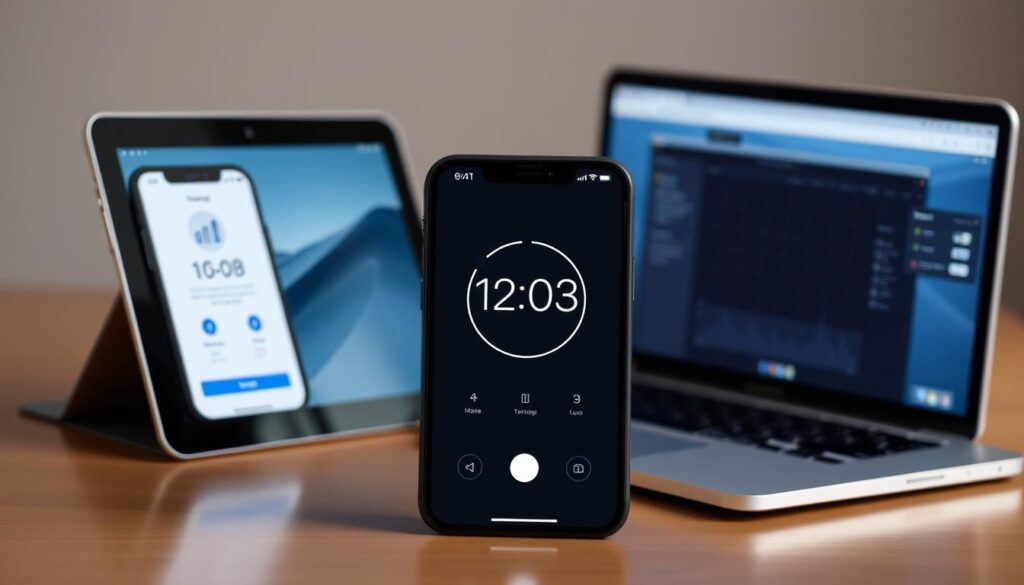Blog
The 5-Minute Rule: Stop Procrastinating and Start Doing

Overcoming procrastination can be a significant challenge for many individuals. The 5-minute rule is a simple yet effective technique to help build momentum and make progress on tasks.
By committing to work on a task for just 5 minutes, individuals can overcome their initial resistance and gain confidence. This technique is particularly useful for tasks that seem daunting or overwhelming.
To get started, identify a task you’ve been putting off and commit to working on it for just 5 minutes. You’ll be surprised at how often you’ll continue working beyond the initial 5 minutes, making significant progress and improving your overall productivity.
Key Takeaways
- Understand the 5-minute rule and its benefits
- Learn how to apply the technique to overcome procrastination
- Discover how to make progress on daunting tasks
- Get tips on getting started with the 5-minute rule
- Improve your overall productivity with a simple technique
Understanding the Psychology of Procrastination
Understanding why we procrastinate is crucial to overcoming it. Procrastination is a widespread challenge that affects productivity, stress levels, and overall well-being. Research suggests that procrastination is often linked to task aversion, fear of failure, and perfectionism.
Why We Procrastinate: The Brain Science
The brain science behind procrastination involves the interplay between the limbic system and the prefrontal cortex. The limbic system, responsible for emotions and impulses, often overrides the prefrontal cortex, which handles decision-making and planning. This override can lead to procrastination as individuals succumb to short-term emotional relief rather than tackling tasks that may induce stress or anxiety.
The Emotional Roots of Task Avoidance
Task avoidance is often emotionally driven. Fear of failure, perfectionism, and task aversion are common emotional roots. When a task seems too daunting or potentially failure-inducing, the emotional response can be to avoid it altogether. This avoidance provides temporary relief but can lead to a cycle of guilt and further procrastination.
How Procrastination Impacts Productivity and Well-being
Procrastination significantly impacts both productivity and well-being. Delayed tasks lead to reduced productivity, increased stress, and a sense of guilt. Chronic procrastination can also affect mental health, contributing to anxiety and depression.
| Impact Area | Effects of Procrastination |
|---|---|
| Productivity | Reduced efficiency, delayed completion of tasks |
| Mental Health | Increased stress, anxiety, potential depression |
| Well-being | Guilt, reduced self-esteem, overall dissatisfaction |
Understanding these aspects of procrastination is essential to addressing it effectively. By recognizing the psychological underpinnings, individuals can begin to develop strategies to overcome procrastination.
What Is the 5-Minute Rule?
Overcoming procrastination is as simple as committing to 5 minutes of work. The 5-minute rule is a simple yet effective technique that involves dedicating just 5 minutes to a task, making it easier to overcome initial resistance and build momentum.
Origins and Development of the Technique
The 5-minute rule has its roots in cognitive-behavioral therapy, where it was used to help individuals overcome procrastination by breaking down tasks into manageable, short intervals. This technique has been widely adopted as a productivity hack due to its simplicity and effectiveness.
Core Principles Behind Its Effectiveness
The core principle behind the 5-minute rule is that getting started is often the hardest part of a task. By committing to just 5 minutes, individuals can overcome the initial inertia and make progress. As Mark Twain once said,
“The secret of getting ahead is getting started.”
This rule leverages the psychological principle that starting a task is the most significant barrier to productivity.
Why Five Minutes Is the Psychological Sweet Spot
Five minutes is long enough to make a start but short enough to not feel overwhelmed. Research suggests that the human brain can focus for about 5-10 minutes before it needs a rest. Thus, 5 minutes is the psychological sweet spot that balances effort and motivation.
| Task Duration | Psychological Impact |
|---|---|
| 1 minute | Too short to make an impact |
| 5 minutes | Ideal for initial commitment |
| 30 minutes | Can be overwhelming for procrastinators |
The Science Behind Why the 5-Minute Rule Works
Research into the psychology of procrastination has revealed that the 5-minute rule leverages key principles to help people get started on tasks they might otherwise avoid. By understanding the underlying science, individuals can harness the full potential of this technique to boost their productivity.
Overcoming Activation Energy and Inertia
The 5-minute rule is effective because it helps individuals overcome the initial resistance to starting a task, known as activation energy. By committing to just five minutes of work, the barrier to entry is significantly lowered, making it easier to begin. Reducing the time commitment makes the task less daunting, allowing individuals to overcome inertia and get started.

Momentum and the Zeigarnik Effect
Once the initial five minutes have passed, momentum often builds, and individuals find themselves continuing to work on the task. This phenomenon is related to the Zeigarnik Effect, which suggests that starting a task creates a sense of tension that motivates individuals to complete it. As people continue working, they are more likely to maintain their momentum.
Neurological Changes During Task Initiation
Recent studies have shed light on the neurological changes that occur when individuals start a task. Task initiation is associated with increased activity in areas of the brain related to motivation and reward.
Recent Research on Starting Triggers
Research has identified specific triggers that can enhance the effectiveness of the 5-minute rule. For example, setting a clear timer or creating a conducive work environment can help individuals stay focused and motivated during the initial five minutes.
Implementing the 5-Minute Rule: Step-by-Step Guide
The key to successfully implementing the 5-minute rule lies in creating an environment conducive to focus and minimizing distractions. This technique is not just about setting a timer; it’s about cultivating a mindset that fosters productivity.
Identifying Tasks That Benefit Most from This Approach
The first step in implementing the 5-minute rule is to identify tasks that are suitable for this technique. These are typically tasks that are daunting or require a significant amount of activation energy. Examples include starting a new project, exercising in the morning, or tackling a cluttered workspace.
Setting Up Your Timer and Environment
Once you’ve identified the tasks, the next step is to set up your timer and environment. Choose a timer that works for you, whether it’s a traditional kitchen timer or a mobile app. For a more detailed exploration of timer apps, you can check out resources like productivity techniques that integrate well with the 5-minute rule.
Creating a Distraction-Free Zone
Creating a distraction-free zone is crucial. This involves turning off notifications on your phone, finding a quiet workspace, or using tools that block distracting websites.
What to Do When the 5 Minutes End
When the 5 minutes are up, you have two main decision points: continue working on the task or complete it if you’ve made significant progress.
Decision Points: Continue or Complete
Assess your progress and decide whether to continue or wrap up the task. Sometimes, you’ll find that you’ve gained enough momentum to keep going.
| Task Type | 5-Minute Rule Effectiveness | Next Steps |
|---|---|---|
| Daunting Tasks | High | Continue or Complete |
| Small Tasks | Moderate | Complete or Batch |
| Creative Tasks | High | Continue or Iterate |
Top Productivity Hacks That Complement the 5-Minute Rule
The 5-minute rule can be even more powerful when used alongside other productivity strategies. By combining this technique with additional hacks, you can significantly enhance your efficiency and achieve more in less time.
Time Blocking Techniques
Time blocking involves scheduling large chunks of uninterrupted time to focus on important tasks. By dedicating specific timeslots to tasks, you can avoid multitasking and minimize distractions. This technique complements the 5-minute rule by providing a structured framework for your workday.
The Pomodoro Method Integration
The Pomodoro method involves working in focused 25-minute increments, followed by a 5-minute break. This technique can be integrated with the 5-minute rule by using the initial 5 minutes to get started on a task, and then continuing with Pomodoro sessions to maintain momentum.
Task Batching for Maximum Efficiency
Task batching involves grouping similar tasks together and completing them in one session. By batching tasks such as checking emails or making phone calls, you can reduce the time and mental energy required to complete them. This technique pairs well with the 5-minute rule, as it helps you stay focused on a single type of task.
Habit Stacking for Consistent Implementation
Habit stacking involves building new habits onto existing ones. By stacking productivity habits such as the 5-minute rule onto your daily routine, you can create a consistent and sustainable productivity system. For example, you could stack the 5-minute rule onto your morning coffee routine to start your day with a productive boost.
| Productivity Hack | Description | Benefit |
|---|---|---|
| Time Blocking | Scheduling large chunks of uninterrupted time | Reduces multitasking and distractions |
| Pomodoro Method | Working in focused 25-minute increments | Maintains momentum and reduces burnout |
| Task Batching | Grouping similar tasks together | Reduces time and mental energy required |
| Habit Stacking | Building new habits onto existing ones | Creates a consistent productivity system |
By incorporating these productivity hacks into your daily routine, you can significantly enhance your efficiency and achieve more in less time. Start by combining the 5-minute rule with one or two additional hacks, and adjust as needed to find the perfect balance for your productivity needs.
Digital Tools and Apps for 5-Minute Productivity
To overcome procrastination, the right digital tools can make all the difference. By leveraging technology, individuals can enhance their productivity and make the most of the 5-minute rule.
Timer Apps Designed for Short Bursts
Timer apps are essential for implementing the 5-minute rule effectively. Apps like Focus Booster and Tomato Timer are designed for short bursts of productivity, allowing users to set timers and stay focused.

Task Management Systems
Efficient task management is crucial for maximizing productivity. Tools like Trello and Asana help users organize tasks, set priorities, and track progress, making it easier to apply the 5-minute rule to various tasks.
Progress Tracking and Analytics
Monitoring progress is vital for maintaining motivation. Apps like Forest and Habitica provide analytics and tracking features that help users understand their productivity patterns and stay on track.
Distraction Blockers for Focus Sessions
Minimizing distractions is key to successful productivity sessions. Tools like Freedom and Cold Turkey block distracting websites and apps, ensuring that users can focus on their tasks without interruptions.
By integrating these digital tools and apps into their daily routine, individuals can significantly enhance their productivity and make the 5-minute rule a powerful habit.
Common Obstacles and How to Overcome Them
Common obstacles can hinder the effectiveness of the 5-minute rule, but there are strategies to overcome them. When implementing this technique, individuals may face challenges that prevent them from making the most out of this productivity hack.
When 5 Minutes Feels Too Long
Sometimes, the task at hand seems so daunting that even dedicating 5 minutes feels overwhelming. In such cases, it’s essential to break down the task into smaller, manageable chunks. This makes the task less intimidating and allows for a more gradual build-up of momentum.
Dealing with Persistent Resistance
Resistance to starting a task is a common phenomenon. To overcome this, it’s crucial to identify the underlying reasons for the resistance. Is it fear of failure, perfectionism, or lack of motivation? Once the root cause is understood, strategies can be developed to address it.
Adapting the Rule for Different Types of Tasks
Not all tasks are created equal, and the 5-minute rule may need to be adapted accordingly. For complex tasks, it might be necessary to extend the initial 5-minute commitment or break the task into smaller segments.
Overcoming the “Just 5 More Minutes” Trap
The “just 5 more minutes” mentality can sometimes lead to procrastination. To avoid this trap, it’s essential to set clear goals and deadlines for the task at hand. This helps maintain focus and ensures that the task is completed in a timely manner.
By understanding and addressing these common obstacles, individuals can more effectively implement the 5-minute rule and enhance their productivity.
5-Minute Rule Applications in Different Life Areas
From creative work to household chores, the 5-minute rule can be adapted to suit various needs. This versatility makes it an invaluable tool for boosting productivity across different aspects of life.
The 5-Minute Rule for Creative and Intellectual Work
For creative and intellectual tasks, the 5-minute rule can help overcome initial resistance. By committing to just 5 minutes of work, individuals can often find themselves fully engaged in the task.
- Start with brainstorming sessions
- Use the rule for writing sprints
- Apply it to research tasks
Applying the Rule to Physical Exercise and Health Habits
The 5-minute rule can be particularly effective for incorporating physical exercise into daily routines. It can be as simple as doing 5 minutes of stretching or a short workout.
Examples include:
- 5-minute morning stretching
- Short yoga sessions
- Brief walks during breaks
Using the Rule for Household Management
Household chores can be daunting, but the 5-minute rule makes them more manageable. Tasks like tidying up or doing a load of laundry become less intimidating when broken down into shorter intervals.
The 5-Minute Rule in Professional Settings
In professional contexts, the 5-minute rule can be applied to tasks like meeting preparation and email management.
Meeting Preparation and Email Management
Preparing for meetings or responding to emails can be done in 5-minute increments. This approach helps in staying on top of tasks without feeling overwhelmed.
By applying the 5-minute rule across various life areas, individuals can significantly enhance their productivity and time management skills. This technique offers a simple yet effective way to get started on tasks and make consistent progress.
Real-Life Success Stories and Case Studies
Real-life examples demonstrate the effectiveness of the 5-minute rule in enhancing productivity and reducing procrastination. Individuals from various backgrounds have successfully applied this technique to overcome their challenges and achieve their goals.
How Professionals Use the 5-Minute Rule
Many professionals have adopted the 5-minute rule to tackle complex tasks and improve their work efficiency. For instance, a marketing executive might use this technique to start working on a challenging campaign, dedicating just five minutes to brainstorming ideas. This initial commitment often leads to a longer period of productive work.
Student Success with the Technique
Students have also benefited significantly from the 5-minute rule. By applying this technique to their study routine, they can overcome the initial resistance to starting a difficult assignment. For example, a student might commit to studying for just five minutes, often finding that they can continue beyond the initial time frame.
Before and After: Productivity Transformations
The impact of the 5-minute rule can be seen in the productivity transformations experienced by individuals. Before adopting this technique, many struggle with procrastination and task avoidance. After implementing the 5-minute rule, they often report a significant increase in their productivity and a decrease in stress related to task initiation.
Lessons from 5-Minute Rule Masters
Those who have mastered the 5-minute rule offer valuable insights into its effective application. They emphasize the importance of consistency and creating a conducive work environment. Additionally, they suggest combining the 5-minute rule with other productivity techniques to maximize its benefits.
By examining these real-life success stories and case studies, it becomes clear that the 5-minute rule is a versatile and effective tool for overcoming procrastination and enhancing productivity. Whether applied to professional tasks, academic pursuits, or personal projects, this technique has the potential to transform the way individuals approach challenging tasks.
Conclusion: From 5 Minutes to Lasting Productivity
By incorporating the 5-minute rule into daily routines, individuals can develop a habit of productivity and make lasting changes. This simple yet effective technique has been shown to boost productivity by helping individuals overcome procrastination and get started on tasks.
As seen in the productivity framework that achieved a 200% increase, combining the 5-minute rule with other productivity hacks like the Pomodoro Technique and time blocking can lead to significant gains. By dedicating just 5 minutes to getting started, individuals can build momentum and make progress on their goals.
To achieve lasting productivity, it’s essential to make the 5-minute rule a consistent habit. By doing so, individuals can overcome initial resistance and develop a mindset that is geared towards taking action and achieving their objectives.








